Some eye diseases can be difficult to spot early on, as people with diabetes can go some time without showing any symptoms at all. That is why regular eye exams are crucial. Of course, if you notice any changes in your vision, contact your eye doctor immediately.
Retinopathy is the leading cause of preventable blindness.
It is caused by damage to the blood vessels of the light-sensitive tissue at the back of the eye (retina).
Symptoms of retinopathy:
- Blurred vision
- A sudden shower of black “floaters” (black or grey specks or strings) in your vision
- Fluctuating vision
- Dark or empty areas of vision
Discovering retinopathy early is key to maintaining eye health. Treatments include:
Injectable medications — These medications are injected in an in-office procedure into the middle of your eye (vitreous), which may help to stop the growth of new blood vessels. It sounds a lot scarier than it actually is. It is a quick procedure and the injection is barely felt because your eye is numbed.
Laser Therapy — This in-office procedure seems scary as well, but it is as easy and as painless as a routine eye exam. Don’t worry, most of the time spent in office is waiting for the numbing and dilation drops to do their job. The two options are:
1) Focal Laser Treatment: This treatment can stop or slow blood and fluid leakage in the eye
2) Scatter Laser Treatment: This treatment can shrink abnormal blood vessels in the eye
Vitrectomy—This procedure, performed in a surgery center or hospital, is conducted by making a tiny incision in your eye to remove blood from the vitreous, as well as scar tissue that's tugging on the retina. This is performed under local or general anesthesia.

